
Apocynaceae is a family of flowering plants that includes trees, shrubs, herbs, stem succulents, and vines, commonly known as the dogbane family, because some taxa were used as dog poison. Members of the family are native to the European, Asian, African, Australian, and American tropics or subtropics, with some temperate members. The former family Asclepiadaceae is considered a subfamily of Apocynaceae and contains 348 genera. A list of Apocynaceae genera may be found here.

According to APG II, the Asclepiadaceae, commonly known as milkweed family, is a former plant family now treated as a subfamily in the Apocynaceae.
Moritz Balthasar Borkhausen was a German naturalist and forester. He took part in the production of Teutsche Ornithologie oder Naturgeschichte aller Vögel Teutschlands in naturgetreuen Abbildungen und Beschreibungen by Johann Conrad Susemihl.

Hoya carnosa, the porcelainflower or wax plant, is an asclepiad species of flowering plant in the dogbane family Apocynaceae. It is one of the many species of Hoya that are native to Eastern Asia and Australia. It is a common house plant grown for its attractive waxy foliage, and sweetly scented flowers. It is grown well in pots and hanging baskets.

Danaus genutia, the common tiger, is one of the common butterflies of India. It belongs to the "crows and tigers", that is, the Danainae group of the brush-footed butterflies family. The butterfly is also called striped tiger in India to differentiate it from the equally common plain tiger, Danaus chrysippus. The species was first described by Pieter Cramer in 1779.

John Muirhead Macfarlane FRSE LLD was a Scottish botanist.

Nicholas Edward Brown was an English plant taxonomist and authority on succulents. He was also an authority on several families of plants, including Asclepiadaceae, Aizoaceae, Labiatae and Cape plants.
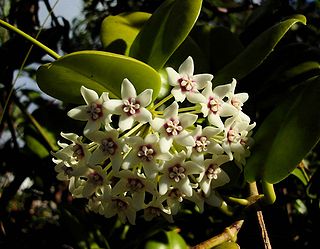
Hoya australis, commonly known as the waxvine or common waxflower, is one of the species in the genus Hoya. It is a vine found on rainforest margins and rocky areas, and occurs in eastern and northern Australia, from Western Australia, through the Northern Territory and coastal Queensland from Cape York to northern New South Wales. It is a popular garden plant, noted for its fragrant flowers.
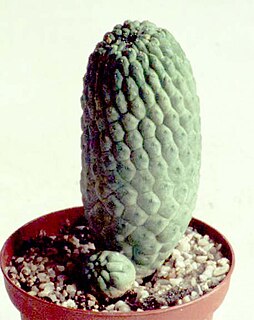
Larryleachia is a genus of stapeliad succulent flowering plants in the family Apocynaceae.
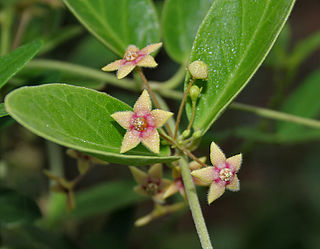
Tylophora is a genus of climbing plant or vine, first described as a genus in 1810. It is native to tropical and subtropical Asia, Africa, and Australia. Most of the species are perennial lianas. The name is derived from the Ancient Greek tylos/τυλος "knot", and phoros/φορος "bearing". The genus was originally erected by Robert Brown for four species he described in Australia. It was placed in the Asclepiadaceae, which has now been sunk into Apocynaceae.

Cynanchum viminale is a leafless succulent plant in the family Apocynaceae. The species is native to West Africa, the Indian Ocean and Western Pacific region. The species' natural range extends from South Africa throughout much of Africa and the Middle East to India, Indochina, Southern China, Indomalaya and into Meganesia. The species is also found on several Indian Oceans islands including Mauritius, Réunion and the Seychelles.

Marsdenia suaveolens, commonly known as the scented milk vine, is a small vine found in New South Wales, Australia. It is found in a variety of habitats in relatively high rainfall areas, from Bega to Port Macquarie. The original specimen was collected at Sydney on 11 May 1802.

Microloma is a small genus of Ceropegia-like twiners and twiggy bushes occurring in mainly arid or fynbos regions in South Africa. They are generally nondescript when not in bloom, but the flowers of most species are incongruously decorative.
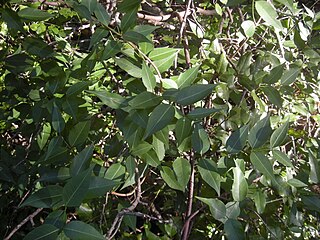
Gymnanthera is a genus of vines in the family Apocynaceae, first described as a genus in 1810. It is native to China, Southeast Asia, and Australia.
- Gymnanthera cunninghamii(Benth.) P.I.Forst. - Enderby Island + Dampier Archipelago of Western Australia
- Gymnanthera oblonga(Burm.f.) P.S.Green - S China, Cambodia, Indonesia, Malaysia, New Guinea, Philippines, Thailand, Vietnam; Australia

Gymnanthera oblonga is a species of vine in the family Apocynaceae from northern Australia, southeast Asia, New Guinea, and southern China.
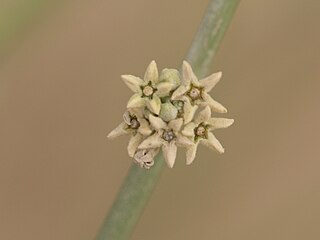
Leptadenia is a genus of plants in the family Apocynaceae, first described as a genus in 1810. It is native to Africa, including Madagascar, as well as southwest Asia and the Indian Subcontinent.
- Leptadenia arborea(Forssk.) Schweinf. - Sudan, Ethiopia
- Leptadenia lancifolia(Schumach. & Thonn.) Decne. - tropical Africa
- Leptadenia madagascariensisDecne. - Madagascar
- Leptadenia pyrotechnica(Forssk.) Decne. - widespread from Algeria to India
- Leptadenia reticulata(Retz.) Wight & Arn. - Madagascar
Pentopetia is a plant genus in the family Apocynaceae, first described as a genus in 1844.
Hermenegild Santapau (1903-1970) was a Spanish born naturalized Indian Jesuit priest and botanist, known for his taxonomical research on Indian flora. He was credited with the Latin nomenclature of several Indian plant species. A recipient of the Order of Alphonsus X the Wise and the Birbal Sahni Medal, he was honoured by the Government of India in 1967, with the award of Padma Shri, the fourth highest Indian civilian award for his contributions to the society.

Ceropegia candelabrum is a plant species from the subfamily Asclepiadoideae. The specific epithet is derived from the candelabra-like appearance of the inflorescences.
Paul Irwin Forster obtained his doctorate in 2004 with his thesis: The pursuit of plants : studies on the systematics, ecology and chemistry of the vascular flora of Australia and related regions, from the University of Queensland.
















